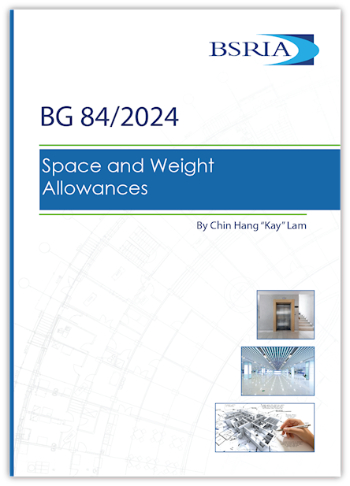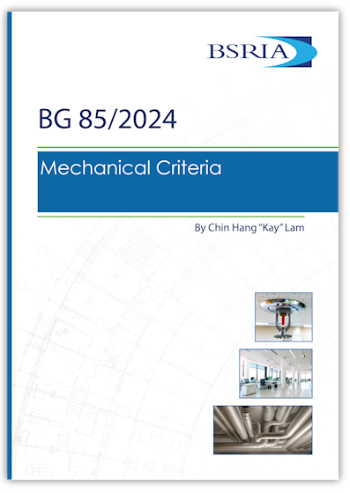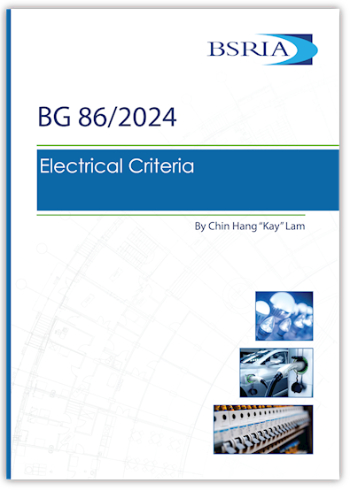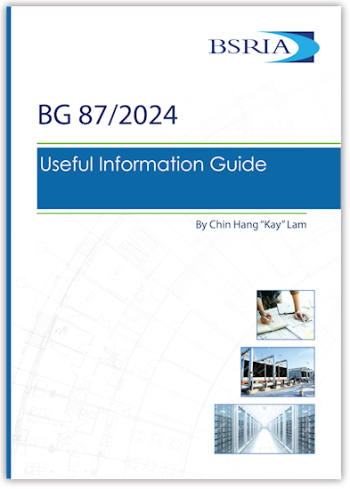New building services publications set to revolutionise design practices
In a significant development for the building services industry, a set of four comprehensive guides were published on 29 February 2024. These publications, collectively designated as BG 84/2024, BG 85/2024, BG 86/2024, and BG 87/2024, promise to usher in a new era of efficiency and innovation in building design.
Contents |
[edit] BG 84/2024: Space and Weight Allowances
One of the cornerstone publications in this release, BG 84/2024, presents a wealth of crucial data on space and weight allowances for mechanical, electrical, and public health equipment. This guide is indispensable for architects, engineers, and designers seeking to optimise spatial planning and ensure compliance with regulatory standards. From floor space allowances to means of escape, BG 84/2024 provides comprehensive insights backed by meticulously curated graphs and information.
BSRIA’s Space and Weight Allowances guide provides useful information for the early stages of design. Graphs are provided on areas, heights and weights of mechanical, electrical and public health equipment. Information is also included on floor space allowances, space for access, occupancy densities and means of escape.

|
This guide partly replaces BG 9/2011 Rules of Thumb 5th Edition. Information has been updated based on consultation with designers and manufacturers, and new information has been provided on lifts and electrical switchgear.
[edit] BG 85/2024: Mechanical Criteria
Another essential addition to the collection, BG 85/2024 focuses on mechanical building services and public health systems. Offering valuable guidance for the early stages of design, this guide covers critical aspects such as heat system temperatures, water consumption, and airtightness criteria. With updated information on residential sprinklers and other key elements, BG 85/2024 equips professionals with the knowledge necessary to enhance efficiency and sustainability in their projects.
This guide provides useful information for the early stages of design of heating, cooling, ventilation and public health systems. This includes heat system temperatures, water consumption and airtightness criteria.
Download the sample preview to view the full table of contents.

|
This guide partly replaces BG 9/2011 Rules of Thumb 5th Edition. Information has been updated based on consultation with designers and manufacturers, and new information has been added, including on residential sprinklers.
[edit] BG 86/2024: Electrical Criteria
In the realm of electrical building services, BG 86/2024 emerges as a definitive resource for design professionals. This guide delves into crucial considerations including voltages, IP ratings, and recommended lighting levels. Moreover, BG 86/2024 introduces new insights into emerging technologies such as photovoltaic systems and electric vehicle charging facilities, reflecting the evolving landscape of electrical design practices.
This guide provides useful information for the early stages of design of electrical building services. This includes voltages, ingress protection (IP) ratings and recommended lighting levels.
Download the sample preview to view the full table of contents.

|
This guide partly replaces BG 9/2011 Rules of Thumb 5th Edition. Information has been updated based on consultation with designers and manufacturers, and new information has been added, including on photovoltaic systems and electric vehicle charging facilities.
[edit] BG 87/2024: Useful Information Guide
Rounding off the quartet of publications, BG 87/2024 serves as a comprehensive reference manual for building services projects. From CO2 emissions factors to compliance criteria with Part L of the Building Regulations, this guide offers a wealth of indispensable information. Notably, BG 87/2024 features an enhanced building services glossary, aiding professionals in navigating industry terminology, alongside valuable updates on resilience classifications for data centres.
This guide provides useful reference information for building services projects. This includes CO2 emissions factors and criteria for compliance with Part L of the Building Regulations.

|
Download the sample preview to view the full table of contents.
This guide partly replaces BG 9/2011 Rules of Thumb 5th Edition. Information has been updated based on consultation with designers and manufacturers. An enhanced building services glossary has been added, defining key terms for the industry, and new information has been included on resilience classifications for data centres and noise ratings.
Superseding BG9/2011
[edit] Concluding comments
It's important to note that these groundbreaking publications will supersede the outdated BG9/2011, reflecting the latest advancements and best practices in the field of building services. By embracing the insights offered by BG 84/2024, BG 85/2024, BG 86/2024, and BG 87/2024, industry professionals can elevate the quality, efficiency, and sustainability of their projects, driving positive outcomes for clients and communities alike.
With these new publications poised to reshape design practices and set new benchmarks for excellence, the future of building services looks brighter than ever before.
This article originally appeared on the BSRIA news and blog site as "Introducing our New BSRIA Guides: BG84/85/86/87" dated February 2024.
--BSRIA
[edit] Related articles on Designing Buildings.
- Approved document L.
- BSRIA articles.
- BSRIA definitions.
- BSRIA.
- Building services.
- Building design process.
- ECA articles.
- Electrical engineer.
- Illustrated Guide to Mechanical Building Services.
- Mechanical and electrical.
- Mechanical, electrical and plumbing MEP.
- Mechanical and electrical.
- Rules of Thumb - Guidelines for building services.
- Space and Weight Allowances BG84 2024.
Featured articles and news
RTPI leader to become new CIOB Chief Executive Officer
Dr Victoria Hills MRTPI, FICE to take over after Caroline Gumble’s departure.
Social and affordable housing, a long term plan for delivery
The “Delivering a Decade of Renewal for Social and Affordable Housing” strategy sets out future path.
A change to adoptive architecture
Effects of global weather warming on architectural detailing, material choice and human interaction.
The proposed publicly owned and backed subsidiary of Homes England, to facilitate new homes.
How big is the problem and what can we do to mitigate the effects?
Overheating guidance and tools for building designers
A number of cool guides to help with the heat.
The UK's Modern Industrial Strategy: A 10 year plan
Previous consultation criticism, current key elements and general support with some persisting reservations.
Building Safety Regulator reforms
New roles, new staff and a new fast track service pave the way for a single construction regulator.
Architectural Technologist CPDs and Communications
CIAT CPD… and how you can do it!
Cooling centres and cool spaces
Managing extreme heat in cities by directing the public to places for heat stress relief and water sources.
Winter gardens: A brief history and warm variations
Extending the season with glass in different forms and terms.
Restoring Great Yarmouth's Winter Gardens
Transforming one of the least sustainable constructions imaginable.
Construction Skills Mission Board launch sector drive
Newly formed government and industry collaboration set strategy for recruiting an additional 100,000 construction workers a year.
New Architects Code comes into effect in September 2025
ARB Architects Code of Conduct and Practice available with ongoing consultation regarding guidance.
Welsh Skills Body (Medr) launches ambitious plan
The new skills body brings together funding and regulation of tertiary education and research for the devolved nation.
Paul Gandy FCIOB announced as next CIOB President
Former Tilbury Douglas CEO takes helm.
UK Infrastructure: A 10 Year Strategy. In brief with reactions
With the National Infrastructure and Service Transformation Authority (NISTA).
























